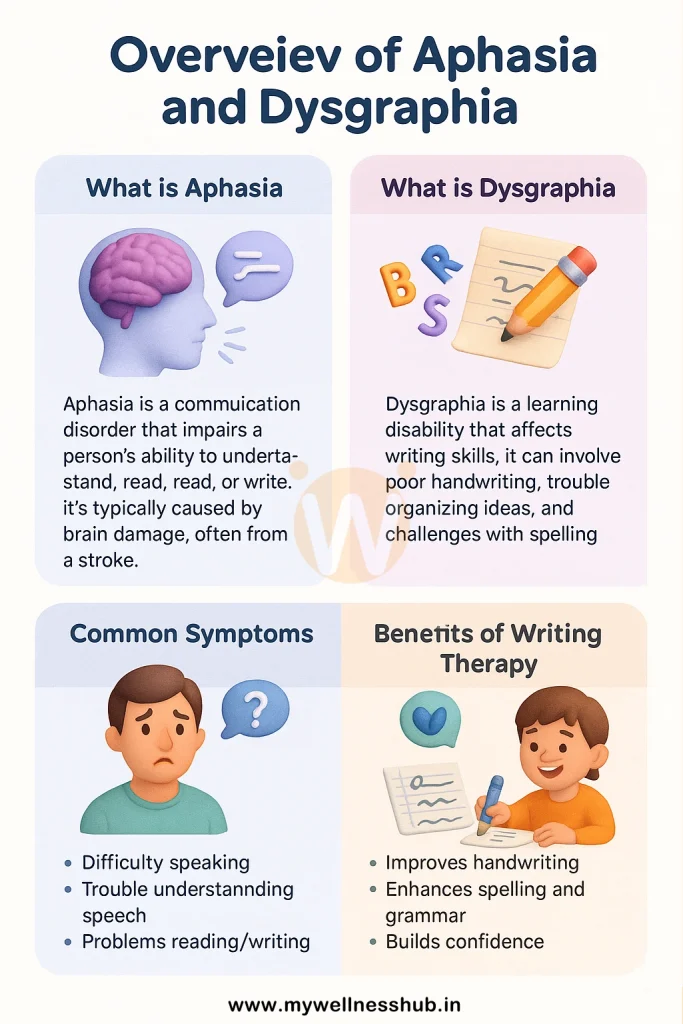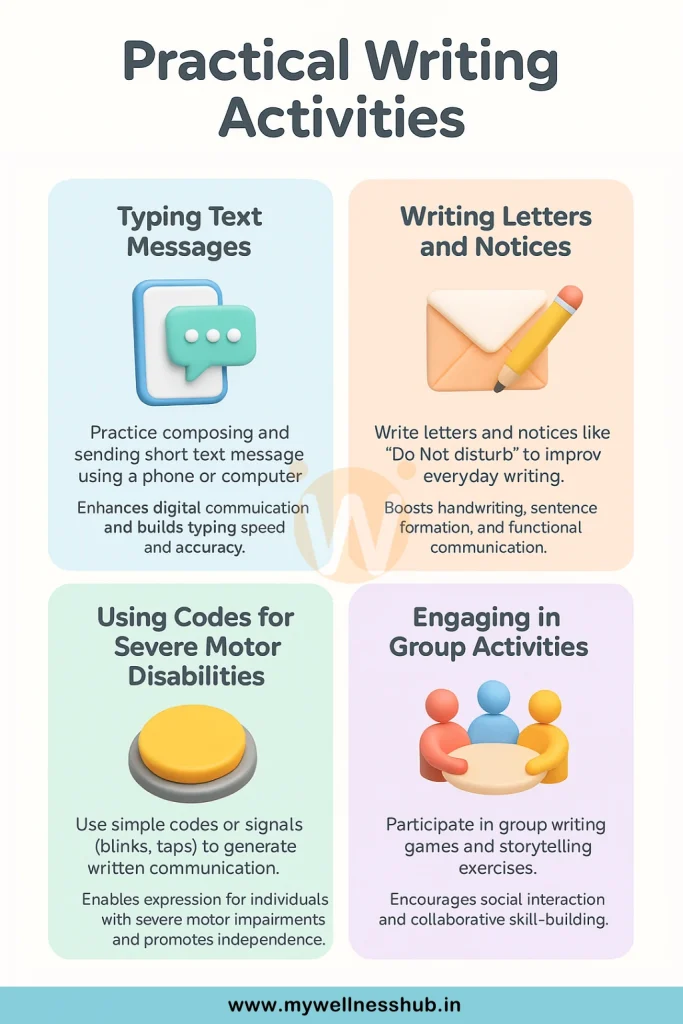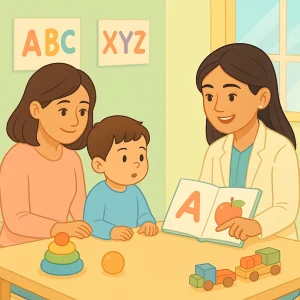Effective Writing Therapy for Aphasia: Tips and Techniques
Last Updated: September 12, 2024
Imagine waking up one day to find that the simple act of writing a note, signing your name, or texting a friend feels like deciphering an ancient script. This is the reality for those living with aphasia, a communication disorder that often follows a stroke or brain injury. Writing, a fundamental skill we often take for granted, becomes a monumental task. Writing therapy, a beacon of hope for individuals with aphasia, is not just about relearning how to form letters on a page; it’s about reclaiming one’s voice in the silent aftermath of loss.
Through personalized techniques and diligent practice, this therapy helps restore the ability to communicate, empowering individuals to express their thoughts and participate fully in life again. Whether it’s drafting a simple shopping list or penning a touching message to a loved one, effective writing therapy transforms daunting challenges into achievable victories.

Understanding Aphasia and Dysgraphia
Aphasia is a communication disorder that results from damage to the parts of the brain that control language. It often occurs after a stroke or brain injury, affecting a person’s ability to speak, understand, read, and write. People with aphasia may have trouble finding the right words, formulating sentences, or understanding what others are saying.
Read More: Aphasia: Causes, Symptoms, Types and Treatment
Dysgraphia, on the other hand, specifically refers to a writing disability. It is a common symptom of aphasia, making it difficult for individuals to write words, sentences, or even their own name. Dysgraphia can manifest in various ways, such as difficulties with spelling, handwriting, or organizing thoughts on paper. This condition can range from mild to severe, significantly impacting a person’s ability to communicate through writing.
For individuals with aphasia, writing therapy offers numerous benefits. Writing therapy can help improve cognitive functions, such as memory and attention, as well as enhance motor skills and coordination. By engaging in writing exercises, individuals can strengthen their ability to express thoughts and ideas more clearly. This, in turn, boosts their confidence and independence in everyday communication.
For a broader understanding of speech and language disorders, you might find our article on speech and language therapy helpful.
Getting Started with Writing Therapy
1. Choosing the Right Environment
Creating a conducive environment for writing therapy is crucial for the success of the sessions. A consistent and accessible location helps in building a routine, making it easier for individuals with aphasia to focus on their writing exercises without unnecessary distractions.
2. Importance of a Consistent and Accessible Location:
Having a regular place for therapy sessions reduces stress and confusion for the participants. It ensures that they know where and when to come for their sessions, promoting a sense of stability and routine. A familiar environment also helps in reducing anxiety, which can be particularly beneficial for individuals struggling with communication challenges.
3. Tips for Finding and Setting Up a Suitable Space:
- Reliability: Choose a location that is consistently available at the same time each week. This could be a room in a community center, library, or even a dedicated space at home.
- Accessibility: Ensure the space is easily accessible for all participants, including those with mobility issues. It should have necessary accommodations like ramps or elevators if needed.
- Comfort: The room should be comfortable, with good lighting and ventilation. A large table and comfortable chairs can make a significant difference.
- Resources: If possible, select a space with additional resources like a whiteboard or chalkboard, which can be useful for group activities and visual aids.
Collecting a variety of writing tools can be crucial. For additional tips on enhancing writing skills, visit our guide on writing skills for students.
Collecting Necessary Materials
Having the right materials is essential for effective writing therapy. A variety of tools can cater to different needs and preferences, making the sessions more engaging and productive.
Essential Materials for Writing Therapy Sessions:
- Writing Tools: Pencils, pens, markers, and rubber grips for those who need assistance with holding writing instruments.
- Paper Supplies: Lined and unlined paper, notebooks, and easel pads. Recycled paper can also be a cost-effective option for practice sheets.
- Organizational Tools: Clipboards, file folders, and photo books to store and organize the client’s work. This helps in tracking progress and maintaining a portfolio of their writing exercises.
- Assistive Devices: If available, incorporate assistive devices like tablets with writing apps, voice-to-text software, and spell check tools. These can help individuals who struggle with traditional writing methods.
Importance of Having a Variety of Tools:
Different individuals have unique needs, and having a variety of tools ensures that therapy can be tailored to each person. For instance, rubber grips can help those with fine motor difficulties, while markers and easel pads can make writing more enjoyable and less intimidating. Assistive technology can bridge the gap for those who find physical writing challenging, ensuring that everyone can participate meaningfully in the therapy sessions.
Techniques and Exercises
Evidence-Based Writing Techniques
Incorporating evidence-based writing techniques into aphasia therapy is crucial for effective and measurable progress. These techniques are grounded in research and have been shown to significantly improve writing skills in individuals with aphasia.
- Phoneme-Grapheme Re-Training: This technique focuses on helping individuals match sounds (phonemes) to their corresponding letters (graphemes). It is particularly useful for those with phonological dysgraphia, where the connection between sounds and letters is impaired.
- Written Naming Tasks: These tasks involve naming objects or pictures through writing. They help in improving word retrieval and spelling, making it easier for individuals to express their thoughts in writing.
- Item-Specific Lexical Spelling Treatment: This method targets specific words that the individual frequently uses. By focusing on these high-use words, it ensures that therapy is practical and immediately beneficial in daily communication.
- Anagram and Copy Treatment (ACT): ACT involves creating words using letter tiles and then copying them. This technique helps in reinforcing correct spelling and word formation.
- Copy and Recall Treatment (CART): Similar to ACT, CART involves copying words and then recalling them later. This repetitive practice aids in long-term retention of spelling patterns and word structure.
Benefits of Using These Techniques in Therapy:
- Personalized Approach: These techniques can be tailored to the individual’s specific needs and abilities.
- Measurable Progress: They provide clear benchmarks for tracking improvement over time.
- Practical Application: Focuses on real-life writing tasks that are meaningful to the individual, enhancing their day-to-day communication.
Practical Writing Activities
In addition to structured techniques, incorporating practical writing activities into therapy can make the sessions more engaging and relevant.
- Typing Text Messages: In today’s digital age, text messaging is a common form of communication. Practicing typing text messages can help individuals with aphasia improve their writing skills in a context that is familiar and useful. Start with simple, single-word messages and gradually increase the complexity as skills improve.
- Writing Letters and Notices: Writing letters, whether formal or informal, is an excellent way to practice structured writing. Notices, such as “Do not disturb” or “Keep the light on,” provide a quick and functional way to improve writing. These activities help in refining sentence structure, spelling, and the overall coherence of written communication.
- Using Codes for Severe Motor Disabilities: For individuals with severe motor disabilities, using codes that can be activated with minimal physical effort (like tapping a finger or blinking an eye) can be very effective. These codes can be translated into written messages, allowing individuals to communicate despite physical limitations.
- Engaging in Group Activities: Group activities provide a social aspect to writing therapy, making it more enjoyable and less isolating. Activities like round-robin writing, collaborative story creation, or even simple games like Hangman can foster a supportive environment where individuals learn from and encourage each other. Group settings also allow for more personalized attention, as therapists can address individual needs within the group context.

Setting Goals and Tracking Progress
Establishing Therapeutic Goals
Setting clear, individualized therapeutic goals is a cornerstone of effective writing therapy for aphasia. These goals provide direction and purpose, ensuring that each session is tailored to the specific needs and interests of the client.
Importance of Setting Individual Goals for Clients:
Each person with aphasia has unique challenges and strengths. By setting individualized goals, therapy becomes more relevant and motivating for the client. Personalized goals ensure that the therapy addresses the specific areas where the client needs the most support, making the sessions more effective and meaningful.
How to Align Writing Exercises with Clients’ Interests and Needs:
- Assessment and Consultation: Start by assessing the client’s current writing abilities and discussing their interests, daily activities, and communication needs. This helps in identifying what is important to them and what they wish to achieve through writing therapy.
- Goal Setting: Based on the assessment, set specific, measurable, achievable, relevant, and time-bound (SMART) goals. For example, a goal might be to write a simple grocery list independently or to send a text message to a family member.
- Customizing Exercises: Design writing exercises that align with these goals. If a client enjoys cooking, incorporate recipe writing into the sessions. If they need to improve functional communication, focus on exercises like writing emails or text messages.
- Engagement: Keep the activities engaging and relevant. This could mean using favorite topics, hobbies, or practical tasks that the client encounters daily.
Baseline Writing Skills Assessment
| Assessment Task | Description | Tools Used |
|---|---|---|
| Spontaneous Writing | Writing without prompts to gauge natural ability | Pen, paper, and prompts for open-ended writing tasks |
| Writing to Dictation | Writing words or sentences spoken by the therapist | Dictation scripts (pre-prepared sentences), pen, and paper |
| Copying Written Text | Copying given text to assess accuracy and fluency | Sample text (e.g., printed sentences or paragraphs), pen, and paper |
| Standardized Assessments | Using standardized tools to evaluate various aspects of writing | WAB (Western Aphasia Battery), BDAE (Boston Diagnostic Aphasia Examination), PALPA (Psycholinguistic Assessments of Language Processing in Aphasia), Johns Hopkins Dysgraphia Battery |
Assessing Writing Skills
Regular assessment of writing skills is crucial for tracking progress and adjusting therapy as needed. It helps in identifying areas of improvement and challenges, allowing for a more targeted approach.
Methods for Assessing Baseline Writing Skills:
- Initial Assessment: Conduct a comprehensive assessment at the start of therapy to determine the client’s baseline writing abilities. This can include tasks like spontaneous writing, writing to dictation, and copying written text.
- Standardized Tools: Use standardized assessment tools such as the Western Aphasia Battery (WAB) or the Boston Diagnostic Aphasia Examination (BDAE) to get a detailed understanding of the client’s writing skills. These tools can provide insights into areas such as word retrieval, sentence structure, and spelling.
Regular Reassessment to Track Progress and Adjust Therapy:
- Ongoing Monitoring: Continuously monitor the client’s progress through regular, informal assessments. This could be as simple as reviewing their written work during each session.
- Periodic Formal Assessments: Conduct formal reassessments at set intervals, such as every 6-8 weeks, using the same tools and methods as the initial assessment. This helps in tracking progress over time and identifying any new challenges or improvements.
- Adjusting Therapy: Based on the assessment results, adjust the therapy plan to address any new needs or to build on areas of progress. This ensures that the therapy remains dynamic and responsive to the client’s evolving abilities.
By setting clear goals and regularly assessing progress, writing therapy for aphasia becomes a structured and effective process. This approach not only helps in achieving tangible improvements in writing skills but also ensures that the therapy is always aligned with the client’s personal needs and goals.
Enhancing Therapy with Technology
Integrating Technology in Writing Therapy
Incorporating technology into writing therapy can significantly enhance the effectiveness and engagement of the sessions. Various technological tools, such as apps and voice dictation software, provide innovative ways to support individuals with aphasia in their writing practice.
Benefits of Using Technology in Therapy:
- Increased Engagement: Technology can make writing exercises more interactive and fun. Apps often have game-like elements that keep users motivated and engaged.
- Accessibility: Tools like voice dictation software can help individuals who have difficulty with physical writing. These technologies allow them to express themselves more easily and accurately.
- Personalized Learning: Many apps offer customizable features that adapt to the user’s skill level, providing a personalized learning experience. This ensures that exercises are neither too easy nor too challenging.
- Instant Feedback: Apps can provide immediate feedback on spelling, grammar, and sentence structure, helping users learn and correct mistakes in real-time.
- Track Progress: Digital tools often come with progress tracking features, allowing the therapist and the client to monitor improvements and identify areas that need more focus.
Tips for Balancing Traditional Writing and Technology-Based Exercises:
- Combine Methods: Use a mix of traditional writing exercises and technology-based tools. For example, a session could start with handwritten exercises to practice fine motor skills and then transition to using a writing app for interactive activities.
- Set Clear Goals: Establish clear goals for both traditional and technological methods. Ensure that each tool used in therapy aligns with these goals and contributes to the overall progress.
- Monitor and Adjust: Regularly monitor the effectiveness of each method. If a particular app or tool is not yielding the desired results, be flexible and willing to try different technologies or revert to more traditional methods.
- Encourage Handwriting: While technology is incredibly beneficial, the physical act of writing is also important for brain and motor skill development. Encourage clients to practice handwriting regularly, even if they also use digital tools.
- Use Technology as a Supplement: View technology as a supplement rather than a replacement for traditional methods. The goal is to enhance the therapy experience, not to depend entirely on digital tools.
By effectively integrating technology into writing therapy, therapists can provide a richer, more varied experience for individuals with aphasia. This balanced approach ensures that clients benefit from both the tactile experience of handwriting and the innovative support that technology offers.
Encouraging Home Practice
Importance of Consistent Practice
Consistent practice is key to making significant progress in writing therapy for individuals with aphasia. Regular practice helps reinforce the skills learned during therapy sessions and ensures continuous improvement. It allows individuals to build on their strengths, work on their weaknesses, and integrate writing into their daily routines, making communication more natural and effective.
Strategies for Encouraging Clients to Practice Writing at Home
- Set Realistic and Achievable Goals: Work with clients to set small, manageable goals that they can achieve at home. These goals should be specific, measurable, and aligned with their interests and daily activities. For example, writing a daily journal entry or composing a short email to a friend.
- Create a Structured Routine: Encourage clients to establish a regular time each day dedicated to writing practice. Consistency helps in forming a habit, making it easier to integrate practice into their daily lives.
- Use Motivating Tools and Resources: Provide clients with engaging materials and resources, such as writing apps, prompts, and templates. Tools like interactive apps or online writing communities can make practice more enjoyable and less of a chore.
- Offer Positive Reinforcement: Regularly check in with clients to review their progress and provide positive feedback. Celebrating their achievements, no matter how small, can boost their confidence and motivation to continue practicing.
- Involve Family and Friends: Encourage family members and friends to support the client’s practice. They can help by providing feedback, engaging in writing activities together, or simply encouraging and reminding the client to practice.
Examples of Home Therapy Tasks and How to Implement Them
- Daily Journal Writing:
- Encourage clients to write about their day, their thoughts, or specific topics of interest. This helps in improving both writing skills and cognitive functions.
- Provide prompts to get them started, such as “What was the best part of your day?” or “Describe your favorite place.”
- Writing Letters or Emails:
- Ask clients to write letters or emails to family members, friends, or even to themselves. This activity helps in practicing sentence structure, spelling, and organizing thoughts.
- Suggest writing thank-you notes, holiday greetings, or updates about their day-to-day life.
- Creating Grocery Lists or To-Do Lists:
- Encourage clients to write their grocery lists or daily to-do lists by hand. This practical task helps in reinforcing functional writing skills.
- Review their lists together to ensure accuracy and completeness, providing gentle corrections if needed.
- Storytelling or Creative Writing:
- Provide prompts for short stories or creative writing exercises. This can be a fun and engaging way to practice more complex writing.
- Examples of prompts include “Write a story about a memorable trip” or “Imagine a day in the life of your favorite animal.”
Personalized and Interactive Approach
1. Getting to Know Your Clients
Understanding your clients’ interests and goals is the foundation of effective writing therapy for aphasia. This personalized approach ensures that therapy is not only relevant but also engaging and motivating for each individual.
2. Importance of Understanding Clients’ Interests and Goals:
Every individual with aphasia has unique experiences, preferences, and aspirations. By getting to know your clients, you can tailor therapy sessions to match their personal interests and daily needs. This approach increases motivation and participation, making therapy sessions more productive and enjoyable.
When clients feel that therapy is aligned with their personal goals, they are more likely to engage fully and make consistent progress. For example, a client who enjoys cooking might be more motivated to participate in writing exercises if they involve writing recipes or grocery lists.
3. How to Create a Client-Centered Therapy Plan:
- Initial Assessment and Conversation:
- Begin with a thorough assessment to understand the client’s current writing abilities, challenges, and preferences.
- Have an open conversation with the client and their family to learn about their interests, daily routines, and specific communication goals.
- Setting Personalized Goals:
- Based on the assessment and conversation, set specific, measurable, and achievable goals that are meaningful to the client. These goals should reflect what the client wants to achieve in their daily life, such as writing emails, creating lists, or telling stories.
- Designing Tailored Exercises:
- Develop writing exercises that align with the client’s interests and goals. For example, if a client loves gardening, incorporate writing tasks like labeling plants, keeping a garden journal, or writing gardening tips.
- Use a variety of formats, such as written prompts, interactive activities, and practical tasks, to keep the sessions engaging and dynamic.
- Incorporating Feedback and Adjustments:
- Regularly seek feedback from the client about what they find helpful or challenging. Use this feedback to adjust the therapy plan as needed.
- Celebrate progress and adjust goals to ensure continuous improvement and maintain motivation.
- Engaging Family and Friends:
- Involve family members and friends in the therapy process. They can provide additional support, encourage practice at home, and help reinforce the client’s progress.
- Create opportunities for social writing activities, such as writing letters to loved ones or sharing stories with family members.
Read more: The Crucial Role of Parents in Online Speech Therapy
Conclusion
Effective writing therapy for aphasia can greatly improve communication skills, cognitive functions, and overall confidence. By using personalized, evidence-based techniques and practical activities, individuals with aphasia can make significant progress in their writing abilities. Regular practice and the use of technology make therapy more engaging and accessible.
It’s important to seek professional help to create a therapy plan tailored to your needs. Professionals ensure that therapy is effective and enjoyable, addressing specific challenges and building on individual strengths. At Wellness Hub, we provide support and resources for aphasia therapy. Visit our speech therapy services page to learn more and get the help you need.
Frequently Asked Questions:
1. What is aphasia writing therapy?
Aphasia writing therapy involves using specific techniques and exercises to help individuals with aphasia improve their writing skills. This therapy is designed to enhance communication abilities by addressing the challenges associated with writing impairments caused by aphasia.
2. How does writing therapy benefit individuals with aphasia?
Writing therapy helps improve cognitive functions, motor skills, and the ability to express thoughts clearly. It boosts confidence, enhances daily communication, and can significantly improve the quality of life for individuals with aphasia.
3. What are some evidence-based writing techniques used in aphasia therapy?
Some effective techniques include Phoneme-Grapheme Re-Training, Written Naming Tasks, Item-Specific Lexical Spelling Treatment, Anagram and Copy Treatment (ACT), and Copy and Recall Treatment (CART).
4. Can technology help in writing therapy for aphasia?
Yes, technology can greatly enhance writing therapy. Apps, voice dictation software, and interactive tools provide engaging and accessible ways to practice writing, offer instant feedback, and track progress.
5. What are practical writing activities for aphasia therapy?
Practical activities include typing text messages, writing letters and notices, using codes for severe motor disabilities, and engaging in group writing exercises. These activities make therapy more relevant and functional.
6. Why is it important to set individual goals in writing therapy?
Setting individual goals ensures that therapy is personalized and relevant to the client’s needs and interests. It makes therapy more motivating and effective, addressing specific areas of difficulty and building on strengths.
7. How can I practice writing at home to improve my skills?
Consistent home practice is crucial. Activities such as daily journal writing, creating grocery lists, writing emails, and using interactive writing apps can help reinforce skills learned during therapy sessions.
8. What should I look for in a writing therapy program for aphasia?
Look for a program that offers personalized, evidence-based techniques, involves technology, and provides ongoing assessment and goal setting. Professional guidance is essential for effective therapy.
9. How can family and friends support someone undergoing writing therapy for aphasia?
Family and friends can encourage regular practice, provide feedback, participate in writing activities, and offer emotional support. Their involvement can significantly enhance the therapy experience.
10. How often should writing therapy sessions be conducted for optimal results?
For optimal results, writing therapy sessions should be conducted regularly, typically several times a week. Consistent practice helps reinforce learning and ensures steady progress.
About the Author:
Anuradha Karanam
Speech-language pathologist (7+ years of experience)
Anuradha Karanam is a skilled speech-language pathologist with over 6 years of experience. Fluent in Tamil, Telugu, Hindi, and English, she specializes in parent counseling, speech sound disorders, fluency assessment, and speech-language evaluations. Anuradha excels at working with children with developmental disorders, offering creative and effective therapy programs. Currently, at Wellness Hub, she holds a BASLP degree and is registered with the RCI (CRR No A85500). Her patience, ambition, and dedication make her a trusted expert in her field.
Book your Free Consultation Today
Parent/Caregiver Info:
Client’s Details:
* Error Message









